Formative assessments are not new to the classroom, but their value has not diminished as new innovative practices steal the limelight. One factor that reduces the implementation of formative assessments in today’s classrooms is the time it takes to evaluate the data collected. Master teachers can informally check student understanding without even putting pen to paper, but these “pulse checks” often do not go beyond the teacher. The usefulness of these assessments comes not from helping students answer questions, but rather by informing instruction.
Why go digital?
With the widespread use of technology, we have broken down the barriers to global communication. Whether you are in the next room or the next country, instant access is not only available, but expected. We should have the same expectations in education. Teachers have long been isolated from one another by classrooms in supervision driven systems. New initiatives for common summative assessments strive to unite the separated instruction. Yet, they demand a consistency not supported by the antiquated school structure. One solution to this separation is digital formative assessments.
By digitizing formative assessments, we can not only instantly check student performance, but also share our results with students, parents, and colleagues. No longer should the teacher be the keeper of the data. Instead, teachers can share findings to identify commonalities across forms of instruction, content areas, and even states.
How does it work?
The two internet-based systems I have tested – Socrative and Geddit – take advantage of the widespread availability of web-enabled devices already in student hands. In my district, the BYOD or Bring Your Own Device initiative has been a game changer for student use of technology. Environments like ours make the old student clicker systems irrelevant and exceedingly costly.
Both programs allow for development of assessments online through a teacher account. Teachers can use quick question formats to save time, but may also create their own quizzes within the system. Students gain access to quizzes through a course code or room number. Once students have joined the digital “classroom”, they are prompted to answer the teacher’s questions. In both Socrative and Geddit, teachers control administering the quiz. However, once the quiz is complete, the two programs begin to differ.
Socrative provides the teacher with choices on reporting. A teacher may download the report immediately or have the report emailed to them. Reporting in Socrative takes the form of an Excel spreadsheet. Those comfortable with the Microsoft Office suite or Google docs will enjoy the ease of filtering data and creating visuals to share with others.
Geddit, on the other hand, maintains the reports online. In a Geddit report, teachers can view a breakdown of the student confidence in their responses, a clear list of students who may have struggled with the content, and a question breakdown.
How to choose?
Out of the many digital formats available for formative assessments, I have only used Socrative, and more recently, Geddit. I first learned of Socrative through a PD I attended and then learned about Geddit through social media. My current preference is Geddit, but I did not make this decision in isolation. Rather, I asked the students.
Student voice in the classroom has proven to increase student ownership of learning. In this case, students had been using the Socrative system for several months and been content. When I discovered that there was a good alternative to how we had been doing formatives, I had the students pilot Geddit.
Our schedule provides students with an opportunity to work on the University of Kentucky’s campus one day a week. Half of our students attend UK on Tuesday and the other half attend on Thursday. Students who attended my class on Tuesday took a formative assessment on the usual Socrative, while students who attended on Thursday took their assessment on Geddit. Thursday students then responded to a quick question on Geddit to vote for the system they preferred. Option A was Geddit is better than Socrative; Option B was Socrative is better than Geddit; Option C was I do not like either; and Option D was I like both. The results are below.
Based on student choice, we are going to discontinue use of Socrative and instead use Geddit.
If you are not ready to bring students into making this choice, here are some teacher-centered considerations when choosing:
1) Comfort with report formats.
If you are not an Excel spreadsheet fan, Socrative may not be the tool for you. However, the benefits of creating your own visuals and filtering specific requests does provide a level of control not easily used with Geddit exporting services. On the flip side, Geddit does provide the visuals for you and if they meet your needs, it saves you the time of creating them.
2) Content area concerns.
As I work with other staff members on digitizing their formative assessments, I have found the needs of each subject are different. Math in particular is tricky as equation editors are not a strong suit for these programs. We did find that when creating quizzes on an iPad uploading a picture from the camera roll to both Socrative and Geddit allowed for a bypass of equation editors.
Another feature that relates to content area is the ability to tag Common Core Standards in the new Socrative 2.0. An easy selection from a list of standards is all it takes to track your use of formatives to assess standards. Alternatively, Geddit offers a topic/activity portion to the lessons where you can type the standard or portion of the standard relevant to the day’s lesson.
3) Student self-evaluation.
Student self-evaluation has become a staple in many innovative classrooms as we continue to value the meta-cognition required by such activities. Both programs provide this feature, but the how may influence your choice. Socrative provides a standard exit slip that allows students to select from choices of confidence. Geddit, on the other hand, incorporates student confidence into all assessments. Geddit features a selection tool that looks like cell phone signal indicators and students evaluate where they stand. The visual representation of understanding vs. selection of the phrase that describes them could alter student responses.
4) Sharability
You may be the first at your school to incorporate digital formative assessments or be a member of a team looking to share data. This, too, will inform your choice between Socrative and Geddit. Socrative has an import and sharing feature using a SOC#. Geddit offers a share by email feature.
5) Accountability
The biggest difference I found between Socrative and Geddit is the need for students to form accounts with Geddit, whereas Socrative does not require a log in. Students first question when it comes to any activity is, “Will this count for a grade?” If you subscribe to the practice of formatives not being graded (even for completion), both programs will serve your needs. However, if you do wish to provide participation or accuracy grades for responses, Geddit might be the better option as it requires students to log in vs. self-identify by typing in their name.
Conclusions
Ultimately, the choice to digitize formative assessments is yours. What I have found is that digital formative assessments have increased student engagement, provided an opportunity for student voice, serve as a tool to track student self-evaluation, and a wonderful possibility for sharing assessments with others.
Implementation is not without its challenges. Use of blended learning in my classroom has illuminated the error in thinking of digital natives as innately digital learners. As with any learning, students must be scaffolded and given clear expectations of how to use the tools provided to them. Yet, as students become comfortable with the technology, they can find some comical ways of entertaining themselves.
When I implemented Socrative, a student accidentally typed in the wrong “room number”. Instead of taking my two question assessment, they stumbled upon a foreign class’s twenty four question assessment. This first student quickly mended the error, but others then joined in the game of trying to find other classes and take their quizzes. I even had a student give a friend at another school the room number for my quiz and had them participate. While this could be a great opportunity for collaboration across locations, it was a bit confusing when looking at my results.
Students have also amused themselves on Geddit by playing with the hand raising feature. A student can alert the teacher that they need help by digitally raising their hand. One young man in particular tested this out Day 1 by raising his hand on Geddit. To illustrate the usefulness of the feature, I called on the student and asked what he needed. Clearly excited by the attention, he replied, “Nothing. I was just stretching.”
The creativity of students always keeps me on my toes!






Hiii …very useful blog .. I really like it 😉
LikeLike
Thank you 🙂
I am new to blogging, but I am passionate about sharing innovative strategies. I hope my posts will continue to be helpful to you.
LikeLike
Geddit’s going under…looking for alternatives. Socrative doesn’t do what I want it to do. Any other suggestions?
LikeLike
What are you using now that geddit is unavailable? I loved that site…. especially the hand raising on confidence level.
LikeLike